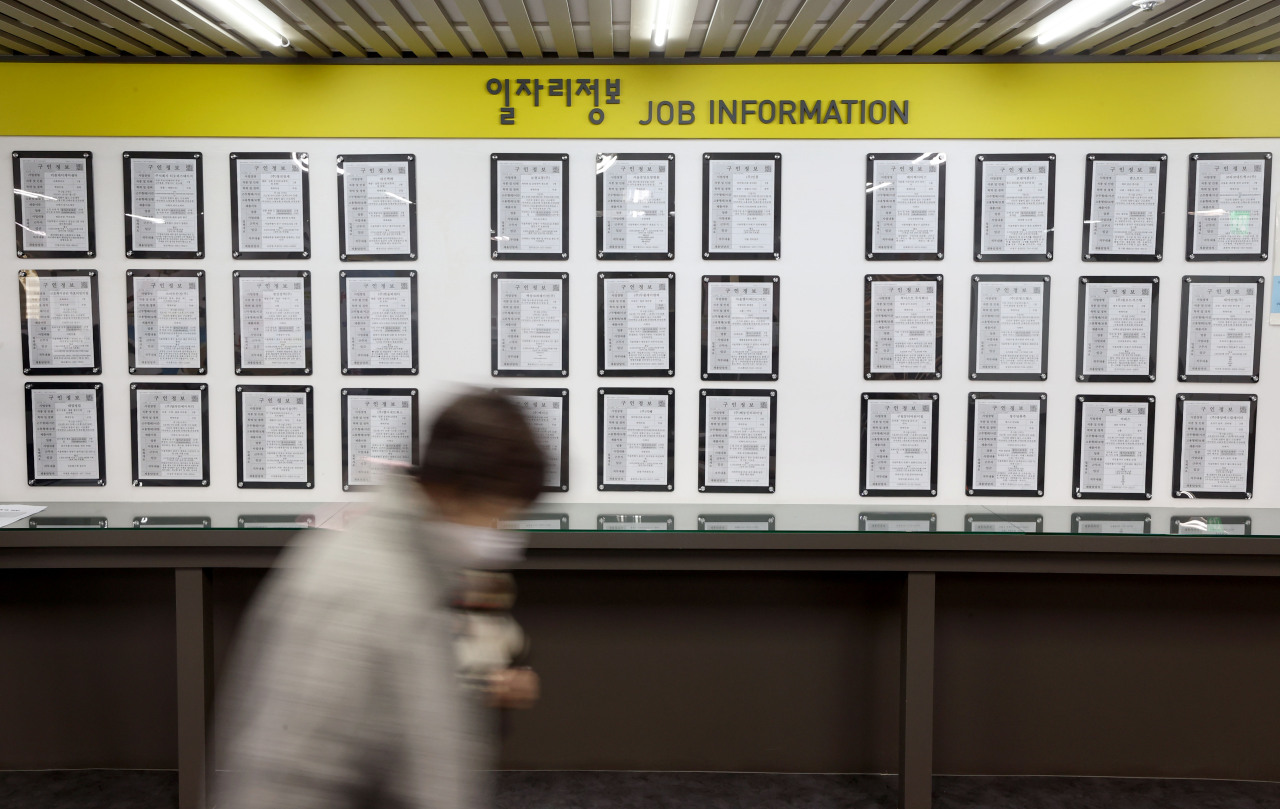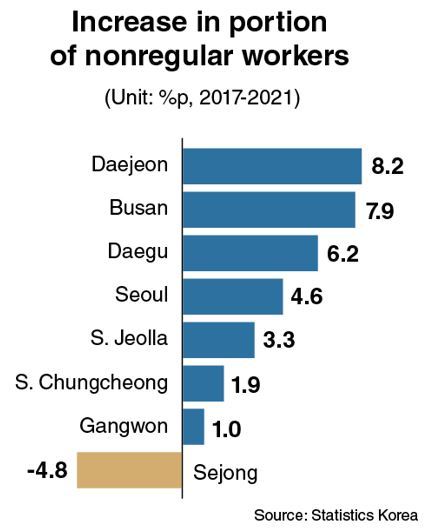 |
A bulletin board at the regional unit of Employment Welfare Plus Center in Seoul shows job information earlier this month. (Yonhap) |
SEJONG – Major cities outside the capital have led the increase in the proportion of nonregular jobs in South Korea over the last four years.
According to Statistics Korea, 38.4 percent of workers had nonregular status in 2021, an all-time high and up 5.5 percentage points from 32.9 percent in 2017, when President Moon Jae-in took office.
Nonregular workers include temporary workers, part-timers and others in underemployed status.
 |
(Graphic by Kim Sun-young/The Korea Herald) |
While the situation is causing weakening job security, data showed that the growth pace in the nonregular job share was particularly fast in metropolitan cities.
Except for Seoul, Sejong and Gwangju, they -- five other metropolitan cities -- saw the portion grow faster than the nationwide average of 5.5 percentage points.
Daejeon had contrasting fortunes with neighboring Sejong. It posted an 8.2 percentage point increase from 32.6 percent in 2017 to 40.8 percent in 2021, while the portion in Sejong fell 4.8 percentage points to 26.7 percent -- the only negative growth among the 17 major cities and provinces.
Busan posted a 7.9 percentage point increase over the corresponding period, followed by Daegu (6.2 percentage points), Ulsan (5.8 percentage points) and Incheon (5.7 percentage points).
The increases for Seoul and Gwangju were 4.6 percentage points and 3.1 percentage points. But the nonregular job portion in the two cities -- 38.5 percent and 40 percent in 2021 -- exceeded the nationwide average of 38.4 percent.
Gyeonggi Province (6.7 percentage points) also outstripped the national average, and South Gyeongsang Province (11.6 percentage points) saw the highest growth among the 17 major regions. Of the nine provinces, the two are the only ones to be home to large cities with populations above 1 million.
Given that the other seven provinces posted growth figures below the nationwide average during the 2017-2021 period, hiring conditions for regular jobs have deteriorated more severely in large cities.
President Moon pledged to convert as many nonregular jobs into regular jobs as possible, particularly in the public sector.
But the data from the Organization for Economic Cooperation and Development showed that Korea ranked No. 2 out of 36 members in the portion of salaried jobs that were “temporary” in 2020, with 26.1 percent. Of the 38 OECD members, Israel and Mexico were not included in the research.
This was up from ranking fourth in 2019 at 24.4 percent and seventh at 21.2 percent.
The OECD defines a temporary employee as a salaried worker whose job has a predetermined termination date. People in this category, alongside part-time or contract workers, are classified as “nonregular” workers in Korea.
Korea overtook the Netherlands, Portugal, Poland, Spain and Chile over the past two years in its reliance on temporary labor.
Korea could possibly top the list in 2021 or 2022, given that the figure held by Colombia, No. 1, continued to fall -- from 28.8 percent in 2018 to 28.76 percent in 2019 and 27.3 percent in 2020.
The figure for Korea was quite high compared to the European Union average of 13.6 percent, the OECD average of 11.4 percent and the Group of Seven average of 8.6 percent in 2020.
It was also far higher than the figures held by neighbors in the Asia-Pacific region: 15.4 percent in Japan and 7.6 percent in New Zealand.
Countries whose figures were under the OECD average included Denmark with 10.9 percent, Iceland with 8.2 percent, Luxembourg with 7.7 percent and Estonia with 2.8 percent.
By Kim Yon-se (
kys@heraldcorp.com)







![[Herald Interview] 'Trump will use tariffs as first line of defense for American manufacturing'](http://res.heraldm.com/phpwas/restmb_idxmake.php?idx=644&simg=/content/image/2024/11/26/20241126050017_0.jpg)
![[Exclusive] Hyundai Mobis eyes closer ties with BYD](http://res.heraldm.com/phpwas/restmb_idxmake.php?idx=644&simg=/content/image/2024/11/25/20241125050044_0.jpg)
